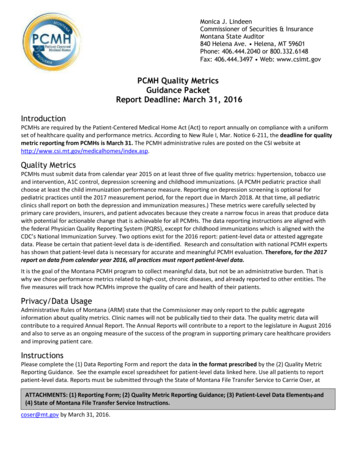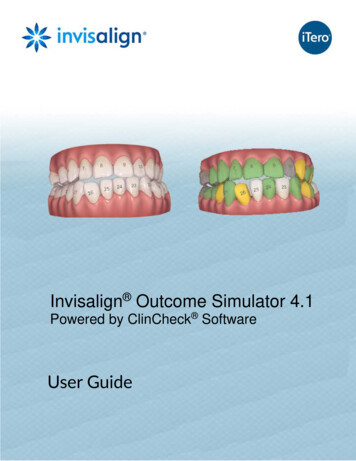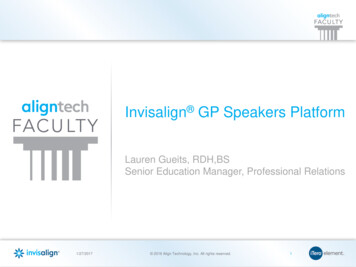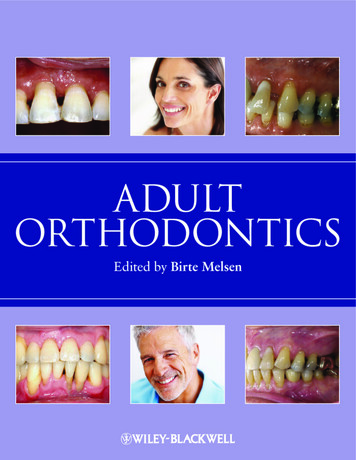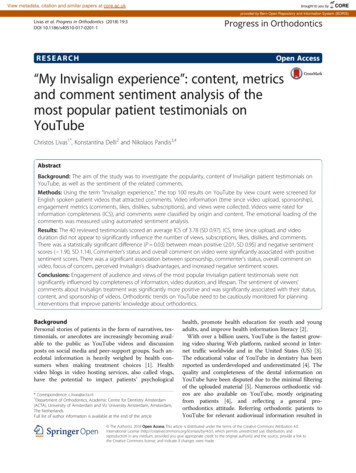
Transcription
View metadata, citation and similar papers at core.ac.ukbrought to you byCOREprovided by Bern Open Repository and Information System (BORIS)Livas et al. Progress in Orthodontics (2018) 19:3DOI 10.1186/s40510-017-0201-1RESEARCHOpen Access“My Invisalign experience”: content, metricsand comment sentiment analysis of themost popular patient testimonials onYouTubeChristos Livas1*, Konstantina Delli2 and Nikolaos Pandis3,4AbstractBackground: The aim of the study was to investigate the popularity, content of Invisalign patient testimonials onYouTube, as well as the sentiment of the related comments.Methods: Using the term “Invisalign experience,” the top 100 results on YouTube by view count were screened forEnglish spoken patient videos that attracted comments. Video information (time since video upload, sponsorship),engagement metrics (comments, likes, dislikes, subscriptions), and views were collected. Videos were rated forinformation completeness (ICS), and comments were classified by origin and content. The emotional loading of thecomments was measured using automated sentiment analysis.Results: The 40 reviewed testimonials scored an average ICS of 3.78 (SD 0.97). ICS, time since upload, and videoduration did not appear to significantly influence the number of views, subscriptions, likes, dislikes, and comments.There was a statistically significant difference (P 0.03) between mean positive (2.01, SD 0.95) and negative sentimentscores ( 1.90, SD 1.14). Commenter’s status and overall comment on video were significantly associated with positivesentiment scores. There was a significant association between sponsorship, commenter’s status, overall comment onvideo, focus of concern, perceived Invisalign’s disadvantages, and increased negative sentiment scores.Conclusions: Engagement of audience and views of the most popular Invisalign patient testimonials were notsignificantly influenced by completeness of information, video duration, and lifespan. The sentiment of viewers’comments about Invisalign treatment was significantly more positive and was significantly associated with their status,content, and sponsorship of videos. Orthodontic trends on YouTube need to be cautiously monitored for planninginterventions that improve patients’ knowledge about orthodontics.BackgroundPersonal stories of patients in the form of narratives, testimonials, or anecdotes are increasingly becoming available to the public as YouTube videos and discussionposts on social media and peer-support groups. Such anecdotal information is heavily weighed by health consumers when making treatment choices [1]. Healthvideo blogs in video hosting services, also called vlogs,have the potential to impact patients’ psychological* Correspondence: c.livas@acta.nl1Department of Orthodontics, Academic Centre for Dentistry Amsterdam(ACTA), University of Amsterdam and VU University Amsterdam, Amsterdam,The NetherlandsFull list of author information is available at the end of the articlehealth, promote health education for youth and youngadults, and improve health information literacy [2].With over a billion users, YouTube is the fastest growing video sharing Web platform, ranked second in Internet traffic worldwide and in the United States (US) [3].The educational value of YouTube in dentistry has beenreported as underdeveloped and underestimated [4]. Thequality and completeness of the dental information onYouTube have been disputed due to the minimal filteringof the uploaded material [5]. Numerous orthodontic videos are also available on YouTube, mostly originatingfrom patients [4], and reflecting a general proorthodontics attitude. Referring orthodontic patients toYouTube for relevant audiovisual information resulted in The Author(s). 2018 Open Access This article is distributed under the terms of the Creative Commons Attribution 4.0International License (http://creativecommons.org/licenses/by/4.0/), which permits unrestricted use, distribution, andreproduction in any medium, provided you give appropriate credit to the original author(s) and the source, provide a link tothe Creative Commons license, and indicate if changes were made.
Livas et al. Progress in Orthodontics (2018) 19:3a significant improvement in patient knowledge comparedto verbal and written instructions [6].Given YouTube is being largely used as a primarysource of orthodontic information [4], it can be presumed that laypersons interested in contemporary systems like Invisalign are likely to access the videosharing platform to answer their queries. Nowadays,89% of US practices perform treatment with clearaligners, while the number of cases has almost doubled within a few years [7]. This upward trend didnot slow down regardless of the limited evidence onthe effectiveness of Invisalign compared to conventional orthodontics [8]. Interestingly, the manufacturerhas recently announced to have reached 4.5 millionInvisalign patients worldwide [9]. Without doubt, thegrowth rate of Invisalign suggests its continued popularity among clinicians and patients. It can be speculated that new communication technologies likeYouTube and other social media might have contributed to the broad acceptance by patients, and especially at younger ages.So far, the available Invisalign information on YouTube videos uploaded by patients-vloggers and theinteraction between vloggers and viewers have notbeen investigated. Therefore, the aims of this studywere (i) to determine the completeness of informationof the most viewed YouTube patient testimonials regarding Invisalign treatment and the emotional content of viewers’ comments and (ii) to evaluate theassociation patterns between video metrics, information completeness, and sentiment of comments.MethodsSearch strategyYouTube (http://www.youtube.com) was searched onJune 10, 2017, using the phrase “Invisalign experience.” Preliminary YouTube search using the specificsearch phrase delivered more relevant results than“Invisalign” and “Invisalign testimonials” and thereforeselected for the study. Before searching, the computerhistory and cookies were deleted. No filters regardingvideo upload date, type, duration, and features wereenabled. The initial search returned 61,300 results. Toreproduce a standard YouTube search of the averageuser [10, 11], the first 100 videos sorted by viewcount were screened for relevance independently bytwo researchers and any disagreement was resolved ina consensus meeting. The following exclusion criteriawere applied: language other than English, videoswithout comments, no personal experience narrative,irrelevant to Invisalign information, testimonials produced by non-patients, insulting wording, poor audiovisual quality, and duplicates.Page 2 of 8Data collectionVideo information (title, hyperlink, vlogger’s name, timesince upload), engagement metrics (comments, likes,dislikes, subscriptions), and view metrics were recordedfor all eligible videos. The description field of each videowas scrutinized for sponsorship statements or endorsement deals.All videos were viewed and available information regarding clinician’s status, Invisalign cost, treatment procedure, complications and comparison between Invisalignand fixed appliances was extracted. Such information hasbeen previously found to attract attention on social media[12]. Subsequently, two researchers (C.L. and K.D.) measured independently the information completeness score(ICS) of the videos, namely rated the videos with 1 pointfor each of the five abovementioned topics covered by thevlogger. Commenter’s status was classified according tothe categories displayed in Table 1. To prevent misinterpretation of the results regarding the target of the comments, only the ones including the word “Invisalign” wereretrieved [13]. Comments were further classified by overallcomment, focus of concern, and Invisalign’s disadvantagesas perceived by the viewer (Table 2).Sentiment analysisSentiment analysis or opinion mining is an approach thatclassifies comments as praise remarks or complaints andcan further process these classifications into actionableareas to improve clinical practice [14]. Sentiment analysisof viewers’ comments on Invisalign was carried out usingSentiStrength software (version 2.2, copyright ProfessorM. Thelwall, Faculty of Science and Engineering,University of Wolverhampton, UK), a sentiment analysistool widely applied to sentiment detection on social network sites [15–19]. SentiStrength [20] is a lexicon-basedclassifier that synthesizes additional (non-lexical) linguisticinformation and rules to measure the strength of positiveTable 1 Commenter’s status according to personal experiencewith or interest in InvisalignViewer statusInvisalign patient (former or present)Fixed appliance patient (former or present)Experienced both types of appliancesInterested in orthodonticsGetting Invisalign soonGetting fixed appliances soonEager to get InvisalignWilling to get but cannot afford InvisalignRegretted getting InvisalignOtherNot specified
Livas et al. Progress in Orthodontics (2018) 19:3Page 3 of 8Table 2 Comment classificationOverall commentFocus of concernFound video useful/informativeTreatment costInvisalign’s disadvantagesPainCommented on vlogger’s reliability/sponsoringComplications (pain, lisp, etc.)LispPositive comment on vlogger’streatment outcomeTreatment duration/wearing timeBad odorNegative comment on vlogger’streatment outcomeCleaning aligners/oral hygieneWearing time/commitmentConfused Invisalign with retainersRetention/stabilityDietary consequencesAsked for further informationEfficiencyPublic embarrassmentOtherTreatment proceduresTreatment costCombinationIf Invisalign indicated for ownmalocclusion/asked for adviceOral symptomsNo commentAsked/shared information about ownmalocclusion/treatment/found similaritiesNot indicated for all casesReason for choosing InvisalignOther (e.g., enamel decalcification)OtherCombinationCombinationNo disadvantages mentionedNo information asked/sharedand negative sentiment in short informal English texts ona scale of 1 (neutral) to 5 (extremely positive/extremely negative). For instance, a text scored with 3, 5would signify moderate positive and very strong negativeemotions. The full text of comments was imported intothe Sentistrength tool, which automatically generated binary reports of positive and negative sentiment strengths.Statistical analysisPaired t test was used to compare the means of positiveand negative sentiment scores. Median regression analysis was used to investigate the association between ICSand engagement and view metrics. To determine the association between positive and negative sentiment scoresand sponsorship, viewer’s status, overall comment, focusof concern, and disadvantages as perceived by viewers,Pearson’s chi-squared test was used. The significancelevel was set at 5%. Statistical analysis was performedusing a statistical software package (STATA 14.2, StataCorporation, College Station, Tex, USA).ResultsYouTube search initially yielded 61,300 results. Afterscreening video titles and watch pages of the first 100videos, the list of results reduced by 19 videos (Fig. 1).After watching the remainder videos and screening thecomments posted by viewers, 40 videos were consideredeligible for the study.Engagement, view metrics, and sponsorshipThe 40 videos were created by 34 unique vloggers with amedian of 2605.5 subscriptions. Descriptive statistics(median, interquartile range; IQR) of video duration, lifespan, and engagement metrics are displayed in Table 3.In total, 663 comments were considered for thepurposes of the study. Align Technology Inc. was acknowledged in one video, whereas one vlogger revealedto have received discount for treatment costs. Five vloggers disclosed information about the Invisalign provider(name, practice, or Web site). Lack of sponsorship wasclearly stated in nine testimonials.Presentation, completeness of information, and video scoresThe analyzed videos presented a mean ICS of 3.78 (SD0.97). Eleven videos achieved the theoretical maximumscore of 5 points. The results of median regression analysis showed no significant association between ICS,video duration, and time since upload and either engagement metrics or views (Table 4). There was a weak evidence of significant association between video durationand view counts (β-coefficient 0.16, P 0.10).Half of the vloggers were treated by orthodontists and17 by dentists. Twenty-nine vloggers were in activetreatment at the time the video was recorded. Mostvloggers discussed treatment aspects like frequency ofchanging trays/practice visits, attachments, wearingtime, and consultation. Procedures like ClinCheck andInterproximal Enamel Reduction (IER) were scarcely reported. Pain, tooth sensitivity, or discomfort were themost frequent side-effects reported by 22 vloggers.Eleven vloggers complained about oral symptoms, andspecifically, mouth dryness and soft tissue irritation.Eleven vloggers had to adjust their dietary habits, while
Livas et al. Progress in Orthodontics (2018) 19:3Page 4 of 8YouTube search:‘Invisalign experience’61,300 videos initially retrievedTitles/watch pages of thefirst 100 videos screenedExcluded videos:7 Irrelevant informationFirst screening4 Without comments3 Not in English2 Uploaded by Align Technology Inc.2 No patient testimonials1 Duplicate81 videos were viewedExcluded videos:23 Produced by practicesSecond screening11 Without Invisalign comments3 Not initiated treatment yet2 Inappropriate wording1 Poor audiovisual quality1 No access possible40 videos finally includedin the analysisFig. 1 Flowchart diagram of the selection processTable 3 Descriptive statistics (median, interquartile range; IQR)of video duration, time since upload, and engagement metricsDuration (sec)MedianIQRTable 4 P values from the median regression analysisfor information completeness score (ICS), views, duration(in seconds), and time since upload (in days)526.0417.5ICSP valueTime since upload sViews10,940.046,529.03 points0.991.000.970.960.98Subscribe2605.57593.54 points0.981.000.990.990.98Likes94.0160.55 .850.940.100.510.21Comments33.056.5Time since upload0.260.870.630.520.67
Livas et al. Progress in Orthodontics (2018) 19:3Page 5 of 8speech was affected (lisp) in ten cases. Fifty percent ofthe vloggers compared Invisalign and fixed appliances,whereas most of them (14 out of 20) did not havepersonal experience with braces.Comment content and sentiment analysisCommenter’s status was not specified in 234 cases, whilemany commenters were related to Invisalign treatment(i.e., 163 former or present patients, 67 motivated to getInvisalign, 41 planning to start treatment soon).Four hundred sixty-nine viewers did not comment onthe video itself, 80 found the video useful/informative,and 31 commented on vlogger’s reliability/sponsoring.Most commenters focused on asking or sharing information about own malocclusion/treatment or even findingsimilarities with the vlogger’s condition, treatment cost,complications, and efficiency. Twenty-four percent ofthe viewers shared their view on Invisalign’s disadvantages with most of them mentioning cost, a combinationof disadvantages, and pain/oral symptoms.There was a statistically significant difference (P 0.03)between mean positive (2.01, SD: 0.95) and negative sentiment scores ( 1.90, SD 1.14). There was a significant association between commenter’s status, overall commenton video, and positive sentiment scores (Table 5). Sponsorship, commenter’s status, overall comment on video,focus of concern, and perceived Invisalign’s disadvantageswere significantly associated with increased negative sentiment scores (Table 5).DiscussionThis study shows that YouTube users viewed massivelyvideos related to Invisalign treatment and interactedwith the creators and fellow viewers. Completeness ofinformation, video duration, and lifespan did not significantly influence the numbers of views, subscriptions,likes, dislikes, and comments. On this basis, the viewingbehavior of YouTube audience may be considered unpredictable, determined by random factors.Almost half of the vloggers were treated by a dentist, afact that reflects the reality in provision of orthodonticcare in the US, where general dental offices have beenTable 5 P values of the Pearson’s chi-squared test for sponsorship,commenter’s status, and comment classificationP valuePositive sentimentNegative sentimentSponsorship0.55 0.001*Commenter’s status 0.001* 0.001*Overall comment 0.001*0.03Focus of concern0.13 0.001*Invisalign’s disadvantages0.27 0.001**Statistically significant at p 0.05carrying out up to 48.9% of orthodontic procedures [21].Hypothetically, a similarly high prevalence of dentistsmay be expected in the 100,000 certified Invisalign providers around the world [9]. Comparison in the use ofInvisalign showed that orthodontists treated generallymore Invisalign cases, though dentists were building faster their caseload [22]. General dentists appeared alsomore willing to treat more complicated malocclusionswith Invisalign [22, 23] adhere less to the digital treatment plan, and use fewer auxiliaries, perhaps demonstrating a difference in treatment goals [23].Treatment procedures as well as complications wereamong the main themes identified in Internet discussion forums visited by orthognathic patients [24]. Problems experienced with braces were also primarilyposted by orthodontic patients in Twitter communication [25]. IER or refinements were rarely described bythe vloggers. Nonetheless, the Invisalign process is notrelied on aligners alone. It requires the standard use ofauxiliaries like attachments, interarch elastics, IER, andaltered aligner geometries to improve the predictabilityof orthodontic movement [8]. Pain and oral symptomswere most frequently reported by vloggers, while theywere also highly viewed as Invisalign’s disadvantage bythe audience. Notwithstanding, Invisalign tends tocause less pain compared to fixed appliances during theinitial stages of treatment, relatively high levels of painmay be anticipated in the first days after insertion [26]or after tray deformation [27]. Several vloggers complained about the need to brush teeth after snacking ortooth sensitivity that made them to adjust the frequency or type of meals (“Invisalign-diet”), which mayquestion the advantage of Invisalign that allows alignerpatients “to enjoy all foods” as Align Technology argues[28]. Speech impairment was frequently noted as sideeffect in the video testimonials. Patients with acrylicplates experienced significantly more pronouncedspeech difficulties than others with fixed appliances[29] and vacuum-formed retainers [30]. Plenty ofviewers appeared to confuse Invisalign aligners withretainers, which might indicate a possible gap inproviding sufficient information by specialists duringconsultation [24]. It is the anonymity of social mediathat allows patients to communicate topics that theyfelt uncomfortable to discuss in person or selfperceived inappropriate to ask directly to health careprofessionals [31].Narratives are believed to provide essential emotionaland social information not usually available throughroutine resources. Another’s experience helps others tounderstand their medical condition, cope, and adjust totreatment regimens [32]. Commenters were mainlyformer, active Invisalign patients or eager to start treatment and shared information about their treatment
Livas et al. Progress in Orthodontics (2018) 19:3experience, occlusion, or even found similarities withthe vlogger’s description. Like other patients participating in Internet forums [24], Invisalign patients soughtonline additional information, support, and reassurancefrom peers undergoing the same process.A multifaceted audience was actively involved inwatching Invisalign testimonials and sharing commentsonline. Besides channel subscribers or candidates forclear aligners, vloggers, professionals (orthodontists,dentists, practice staff, lab technician), the manufacturer,product promoters (i.e., vibration device claimed to facilitate tooth movement, aligner seating tool), and research recruiters intervened by posting comments. Theinterest of different viewers’ groups confirms the claimedpotential of social media to monitor public response tohealth issues, identify misinformation, and identify targeted areas for intervention efforts [33].As YouTube users commonly engage in active discussion by expressing either positive or negative emotionsin their messages [34], this study further analyzed theemotional content of the comments about the vlogger’sexperience with Invisalign. Overall, the positive loadingof the comments was significantly more pronouncedthan the negative loading, though both positive andnegative mean sentiment scores indicated mild emotions. Likewise, a recent Twitter analysis of the patientexperience with braces vs Invisalign revealed more positive tweets about orthodontic treatment without significant differences in sentiment between braces andInvisalign tweets [13]. Viewer’s status, comment content,and sponsorship of videos were significantly associatedwith the sentiments lying behind the comments. Paidpatient testimonials are nowadays commonplace acrossvarious specialties. Dental, ophthalmologic, and plasticsurgery clinics are routinely recruiting patients to helpadvertise-witness their experience on video testimonialsoffering treatment discounts [35]. In the present study,the viewers questioned the consumer’s opinion in sponsored reviews and expressed negative comments aboutthe reliability and the motives of the vlogger implyingbias driven by financial interests.Narrative communication through social media can improve users’ learning abilities by providing ideal healthrole models. On the contrary, sharing information withinpersonal stories may also hide risks, especially when actingas a deterrent for patients from visiting health professionals or the public may not know how to correctly applyonline information about their personal health situation.Since videos involving patient experiences are of lowereducational value than expert led ones [36], professionalassociations and academic departments need to take thelead, to develop and disseminate online evidence-basededucational videos. Several YouTube and Vimeo videolinks (i.e., patient testimonials, instructions aboutPage 6 of 8eating, brushing during orthodontic treatment,retention, etc.) are available on the Web site of theAmerican Association of Orthodontists (AAO).Additionally, AAO has created its own YouTubechannel, which currently hosts more than 50 videosthat basically aim to promote the benefits of orthodontics to the larger society. By expanding topics to standard and innovative techniques and materials, users ofvideo sharing platforms will get access to reliable andupdated patient education materials. Clinicians shouldassist patients in navigating social media and embed onthe web pages of their practices links to valid information sources [5].Study strengths and limitationsThis is the first study to investigate information sharingand interaction trends among YouTube users regardingInvisalign treatment. The use of qualitative research inhealth care enables an in-depth understanding of patients’ thoughts and experiences [24]. Since the researcher is not present during data collection and theconversations analyzed occur naturally, the introductionof bias by the researcher is prevented. Automated sentiment analysis by means of SentiStrength is useful in processing short comments because it extracts both positiveand negative sentiments contained in textual statements[37]. Moreover, SentiStrength outperforms other lexicalclassifiers [36] and therefore may be assumed to havestrengthened our methodology.Like in most studies on consumer health YouTube videos [37], the first five pages of search results were reviewed.A more sophisticated “snowballing” than a sequentialscreening approach has been recommended instead toidentify relevant content through the suggested videos generated by YouTube algorithm [11]. However, it remainsstill unclear whether such strategy represents the commonpractice in YouTube searches. Taking into considerationthe YouTube dynamics, the search results and the studyimplications apply only for the specific search date. Albeitthe five-point rating scale used in this study was selfdeveloped and not pre-validated, it provided to some degree a measure of the comprehensiveness of informationcovering treatment aspects that typically concern users ofsocial media and online discussion groups [12, 24, 25].Future research should further invest in monitoring theorthodontic interests and sentiments of social media usersand developing patient education interventions that meetpatients’ expectations and needs.Conclusions There is an intense activity on YouTube onobtaining information regarding treatment withInvisalign aligners.
Livas et al. Progress in Orthodontics (2018) 19:3 The emotional loading of viewers’ comments aboutInvisalign aligners was significantly more positiveand was significantly associated with their status,content, and sponsorship of videos. Range of information, video duration, and time sinceupload did not significantly influence engagementand view metrics, a finding that warns against theunpredictable viewing preferences of YouTube users,and the incomplete information in popularInvisalign patient testimonials.AcknowledgementsThe authors wish to thank Professor M. Thelwall, Faculty of Science andEngineering, University of Wolverhampton, UK, for kindly granting access toSentiStrength software for the purposes of the study.Authors’ contributionsCL and KD designed the study, collected and interpreted data, and draftedpaper. NP analyzed and interpreted data. All authors read and approved thefinal manuscript.Competing interestsThe authors declare that they have no competing interests.Publisher’s NoteSpringer Nature remains neutral with regard to jurisdictional claims inpublished maps and institutional affiliations.Author details1Department of Orthodontics, Academic Centre for Dentistry Amsterdam(ACTA), University of Amsterdam and VU University Amsterdam, Amsterdam,The Netherlands. 2Department of Oral and Maxillofacial Surgery, University ofGroningen, University Medical Center Groningen, Groningen, TheNetherlands. 3Department of Orthodontics and Dentofacial Orthopaedics,School of Dental Medicine, University of Bern, Bern, Switzerland. 4Privatepractice, Corfu, Greece.Received: 6 November 2017 Accepted: 17 December 2017References1. Fagerlin A, Wang C, Ubel PA. Reducing the influence of anecdotalreasoning on people’s health care decisions: is a picture worth a thousandstatistics? Med Decis Mak. 2005;25:398–405.2. Huh J, Liu LS, Neogi T, Inkpen K, Pratt W. Health vlogs as social support forchronic illness management. ACM Trans Comput Hum Interact.2014;21:23.3. Alexa. youtube.com Traffic Statistics. http://www.alexa.com/siteinfo/youtube.com. Accessed 7 Aug 2017.4. Knösel M, Jung K. Informational value and bias of videos related toorthodontics screened on a video-sharing Web site. Angle Orthod. 2011;81(3):532–9.5. Delli K, Livas C, Vissink A, Spijkervet FK. Is YouTube useful as a source ofinformation for Sjögren’s syndrome? Oral Dis. 2016;22:196–201.6. Al-Silwadi FM, Gill DS, Petrie A, Cunningham SJ. Effect of social media inimproving knowledge among patients having fixed appliance orthodontictreatment: a single-center randomized controlled trial. Am J OrthodDentofac Orthop. 2015;148:231–7.7. Keim RG, Gottlieb E, Vogels DS 3rd, Vogels PB. JCO study of orthodonticdiagnosis and treatment procedures, Part 1: results and trends. J ClinOrthod. 2014;48:607–30.8. Rossini G, Parrini S, Castroflorio T, Deregibus A, Debernardi CL. Efficacy ofclear aligners in controlling orthodontic tooth movement: a systematicreview. Angle Orthod. 2015;85:881–9.9. Invisalign. 4.5 Million Smiles. es. Accessed 14 Aug 2017.10. Fat MJL, Sell E, Barrowman N, Doja A. Public perception of tourettesyndrome on YouTube. J Child Neurol. 2012;27(8):1011–6.Page 7 of 811. Sampson M, Cumber J, Li C, Pound CM, Fuller A, Harrison D. A systematicreview of methods for studying consumer health YouTube videos, withimplications for systematic reviews. PeerJ. 2013;1:e14.12. Detels R, Gulliford M, Karim QA, Tan CC. New communication technologies,social media, and public health, Oxford textbook of global public health,vol. 1. 6th ed. Oxford: Oxford University Press; 2015. p. 391.13. Noll D, Mahon B, Shroff B, Carrico C, Lindauer SJ. Twitter analysis of theorthodontic patient experience with braces vs Invisalign. Angle Orthod.2017;87:377–83.14. Pang B, Lee L. Opinion mining and sentiment analysis. Found Trends InfRetr. 2008;2:1–135.15. Suvakov M, Mitrovic M, Gligorijevic V, Tadic B. How the online socialnetworks are used: dialogues-based structure of MySpace. J R Soc Interface.2013;10:20120819.16. Iosub D, Laniado D, Castillo C, Fuster Morell M, Kaltenbrunner A. Emotionsunder discussion: gender, status and communication in onlinecollaboration. PLoS One. 2014;9:e104880.17. Bhattacharya S, Srinivasan P, Polgreen P. Engagement with health agencieson twitter. PLoS One. 2014;9:e112235.18. Rodrigues RG, das Dores RM, Camilo-Junior CG, Rosa TC. SentiHealth-Cancer:a sentiment analysis tool to help detecting mood of patients in onlinesocial networks. Int J Med Inform. 2016;85:80–95.19. Charlton N, Singleton C, Greetham DV. In the mood: the dynamics ofcollective sentiments on Twitter. R Soc Open Sci. 2016;3:160162.20. Thelwall M, Buckley K, Paltoglou G, Cai D, Kappas A. Sentiment strengthdetection in short informal text. J Am Soc Inf Sci. 2010;61:2544–58.21. del Aguila MA, Anderson M, Porterfield D, Robertson PB. Patterns of oral
“My Invisalign experience”: content, metrics and comment sentiment analysis of the most popular patient testimonials on . Procedures like ClinCheck and Interproximal Enamel Reduction (IER) were scarcely re-ported. Pain, tooth sensitivity, or discomfort wer

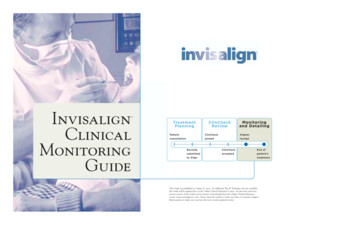
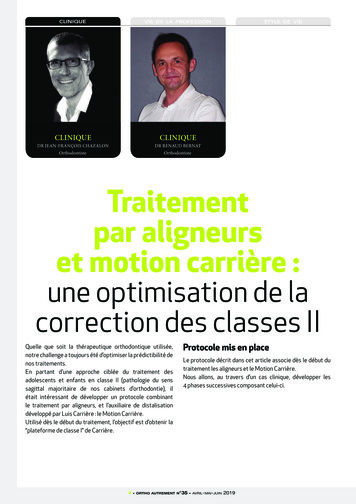
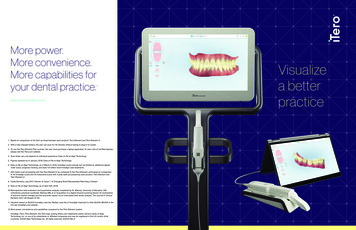
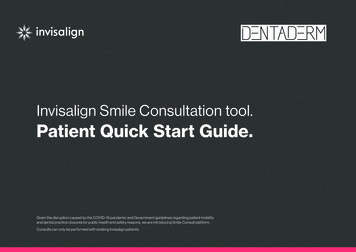
![Welcome [neso ]](/img/18/neso-2019-onsite-program.jpg)

